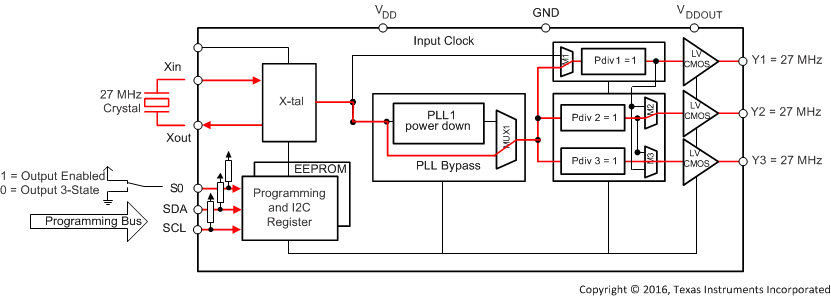ZHCS385D June 2013 – February 2024 CDCE913-Q1 , CDCEL913-Q1
PRODUCTION DATA
- 1
- 1 特性
- 2 应用
- 3 说明
- 4 Device Comparison
- 5 Pin Configuration and Functions
- 6 Specifications
- 7 Parameter Measurement Information
- 8 Detailed Description
- 9 Application and Implementation
- 10Register Maps
- 11器件和文档支持
- 12Revision History
- 13Mechanical, Packaging, and Orderable Information
8.3.2 Default Device Configuration
The internal EEPROM of the CDCE913-Q1 and CDCEL913-Q1 devices is preconfigured with a factory default configuration, as shown in Figure 8-1 The input frequency is passed through the output as a default, thus allowing the device to operate in default mode without the extra production step of programming it. The default setting appears after power is supplied or after a power-down–power-up sequence until the device is reprogrammed by the user to a different application configuration. A new register setting is programmed through the serial I2C interface.
 Figure 8-1 Default Configuration
Figure 8-1 Default ConfigurationTable 8-6 shows the factory default setting for the Control Terminal register. While eight different register settings are possible, in the default configuration, only the first two settings (0 and 1) can be selected with S0, as S1 and S2 are configured as programming pins in default mode.
| Y1 | PLL1 SETTINGS | |||||
|---|---|---|---|---|---|---|
| EXTERNAL CONTROL PINS | OUTPUT SELECTION | FREQUENCY SELECTION | SSC SELECTION | OUTPUT SELECTION | ||
| S2 | S1 | S0 | Y1 | FS1 | SSC1 | Y2Y3 |
| SCL (I2C) | SDA (I2C) | 0 | 3-state | fVCO1_0 | Off | Hi-Z state |
| SCL (I2C) | SDA (I2C) | 1 | Enabled | fVCO1_0 | Off | Enabled |